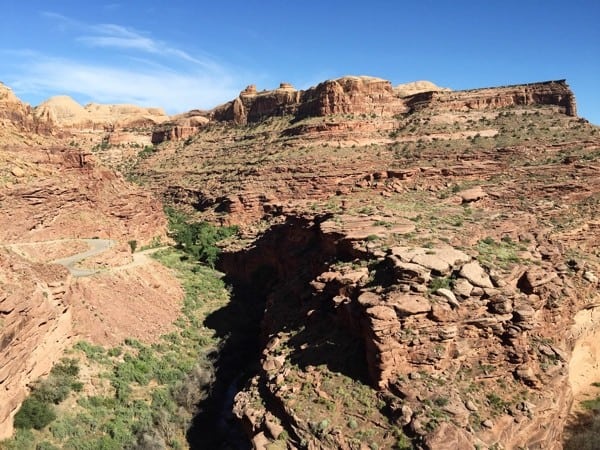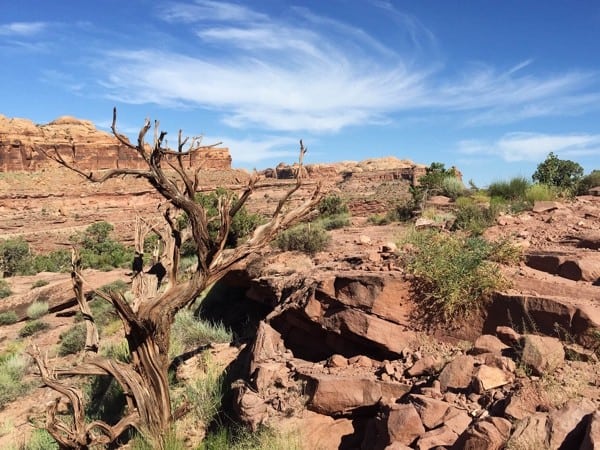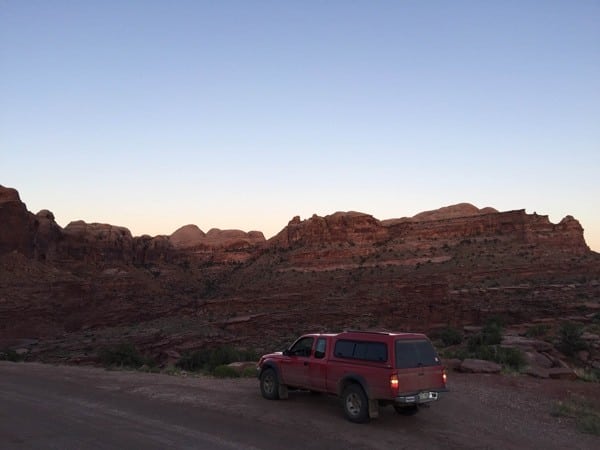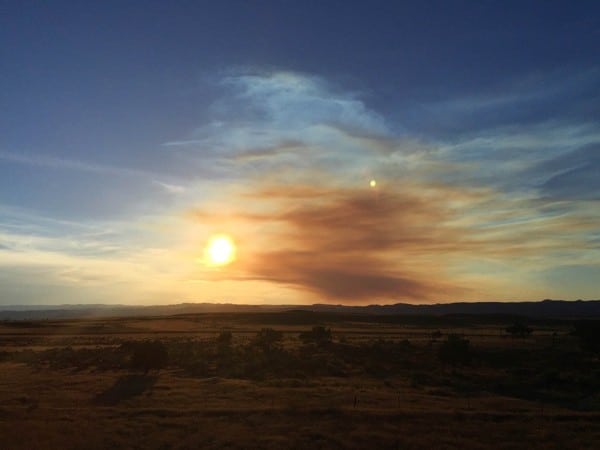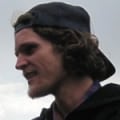Sitting at a coffee-shop patio in Moab, Utah, I check the weather app on my phone which indicates it is 103 degrees Fahrenheit while suggesting it feels like 98F. It reminds me of times I have spent in Alaska in the winter when people would debate weather extremes at the other end of the spectrum.
“Does -40F really feel colder than -30F? Isn’t it all just cold?” It is all just cold, but a 10-degree difference is noticeable and today 103, feels like 103 to me, and the perfect temperature to go for a run. I would never say anything of the like if I was not running Western States in a week, where dealing with heat plays a major part in one’s success or failure in the race.
Deanne, dog, and I head out of town to Hunter Canyon, a somewhat randomly selected camping spot for the night based on its proximity to town and promise (from the guy at the gear shop) of spectacular scenery, in a (hopefully) pretty quiet setting.
Moab is a strange place, where the most magnificent and captivating land clashes with excessive and obnoxious off-road tourism. In a way, this is reflective of my own conflicted state of mind heading into the canyons. Part of me craves the feeling of letting go of schedules and the organized framework that governs our lives, falling instead into the natural rhythms of the desert. Another part of me feels a slight bit of anxiety in leaving the comforts of ‘virtual connectedness’ behind. It is not something I necessarily care to admit. I would much rather experience a seamless transition from virtual to real, disconnect to truly connect with my environment. The truth is that the transition takes a little time and my eyes need to adjust from the bright screen to the desert sun.
Of course, I do spend plenty of time outside every day and am for the most part fully engaged in my surroundings. However, temporary engagement has a different feel (and different commitment level) than full immersion. Being a part of one’s environment, completely captivated and aware, is much different than simply passing by or existing passively in a place.
After establishing camp, tucked between tall red cliffs and large cottonwoods, I set off up Kane Creek Road for a run. Dog, having decided to wear her black fleece for the trip, is content to stay behind, lounging in the shade and chasing the occasional lizard, while Deanne enjoys a book next to the creek.
The air is dry and oppressive, searing into my lungs with each wheezy inhalation. My legs are heavy. I think about how strange it is to start a run in such heat feeling simultaneously warmed up, but not. I have settled in to a decent pace by the time I reach the Amasa Back/Cliffhanger Trail. Fortunately, there is no one there and I savor a solitary climb up to Jackson Hole rim. The trail is surreal, cut into the cliffside, meandering through striking rock formations. On the way back down from the rim, I really start to feel the heat. Kane Creek is nothing more than a sandy wash, with a few murky puddles. I pause nonetheless and sit in the water that barely laps the back of my legs. It feels disappointingly warm. Sweat pours from my forehead and back in this breeze-less space.
I am brought back for a moment to the Copper Canyon of Mexico, in a kind of sensory memory, something about the smell, the texture of the air. I distinctly remember a moment similar to this on the hike from Batopilas to Urique, sitting in a puddle, where the logic of where I am in the world evaporates in the heat and I slip briefly into the very fabric of a place. Perhaps it is the contrast of beauty and harshness, the dangerously alluring pull of the desert, that helps bring my mind into focus. As I run back toward camp, I am filled with a sense of serenity, appreciative of how a short run can so rapidly connect me to a place’s natural rhythms.
Call for Comments (from Meghan)
- While the environments considered are near opposites and the writing angles are a bit different, this essay bears some familiarity to Geoff Roes’s article last week called “Flowing with the Natural World.” What similarities and differences do you see among Joe and Geoff’s approaches to movement with nature?
- When was the last time that nature lulled you into its rhythms, whether the effect was one you were seeking or an unintentional byproduct of your headspace and activities?
- For those of you running Western States later this week, how will you attempt to run according to nature’s rhythms, even though the conditions are challenging?
